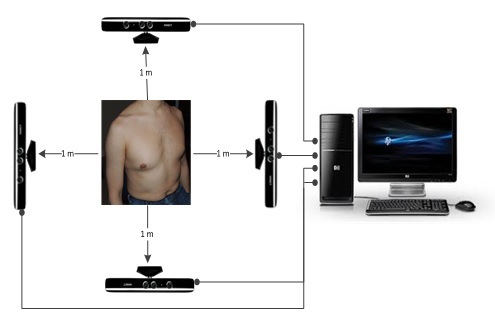Microsoft’s Xbox Kinect breathes new life into respiratory assessment
 Xbox Kinects could be used in the future to assess the health of patients with conditions such as cystic fibrosis.
Xbox Kinects could be used in the future to assess the health of patients with conditions such as cystic fibrosis.
Normally found in the hands of gamers rather than medics the Microsoft sensors could be used to assess the respiratory function of patients.
Researchers at the Institute of Digital Healthcare, WMG, University of Warwick and the Institute of Inflammation and Ageing, University of Birmingham and Heart of England NHS Foundation Trust (HEFT) have developed a method of using the devices. The system consists of four Kinect sensors which are capable of quickly creating a 3D image of a patient’s torso. This enables physicians to measure and assess how a chest wall moves.
In tests it has proven to be as accurate as a patient breathing into a spirometer - the current method used - but providing additional information about the movement of the chest, which could help in identifying numerous respiratory problems.
The project lead, Dr Chris Golby at the Institute of Digital Healthcare, said: “We have developed a low-cost prototype which provides a more comprehensive measurement of a patient’s breathing then existing methods.”
Their work is detailed in their paper Chest Wall motion Analysis in Healthy Volunteers and Adults with Cystic Fibrosis using a Novel Kinect-based Motion Tracking Sensor which is published in Medical & Biological Engineering & Computing.
Spirometry is the technique most commonly used to treat lung diseases including chronic bronchitis, emphysema and chronic obstructive airways. It requires a patient to take the deepest breath they can, and then exhale into the sensor as hard as possible, for as long as possible. However it has significant limitations as it doesn’t allow doctors to assess how different areas of each lung function. It can result in inaccurate readings of some patients’ breathing such as older people and children, and those with facial abnormalities or muscle weakness are often unable to form a tight seal around the mouthpiece.
Dr Golby said: “For patients who report to A&E a quick and low-cost method of chest wall motion assessment is required. There are some conditions that doctors can’t detect or assess using spirometry such as collapsed lung segments or respiratory muscle weakness. However our prototype allows physicians to make accurate assessments.
“It is also potentially very useful in assessing changes in respiratory physiology that occur during exercise. This is in contrast with existing systems which rely on data from one viewpoint.”
Babu Naidu, Chief Investigator, Thoracic Surgeon at HEFT and clinical scientist at the University Birmingham said: “‘A ‘game changer’ in screening, diagnostics, monitoring therapy and providing bio feedback the Xbox can be used in any condition affecting breathing.”
Respiratory diseases kill one in five people in the UK and cost the NHS more than £6billion a year. However the proposed system consists of software and four Kinect sensors each of which cost just £100.
Professor Theo Arvanitis, Head of Research at Institute of Digital Healthcare, WMG, said: “With this and other technologies developed here we hope to innovate in e-healthcare and translate these advances into clinical practice.”
The academics trialled their prototype initially using a resuscitation mannequin, then on healthy volunteers and adults with cystic fibrosis. As the Kinect has an infrared beam it allowed them to measure changes in distances across the chest wall. The system uses four sensors which allow measurement of movement from more than one viewpoint. Using off-the-shelf and bespoke software they were able to create a 3D image of a patient’s chest wall.
The University of Warwick team are now planning to develop their prototype further using Microsoft’s new version of the Kinect, working with cystic fibrosis and other respiratory conditions.
22 March 2016
Image: illustration of Kinect system
DOI: 10.11007/s11517-015-1433-1
For media enquiries please contact Nicola Jones, Communications Manager, University of Warwick 07920531221 or N.Jones.1@warwick.ac.uk

